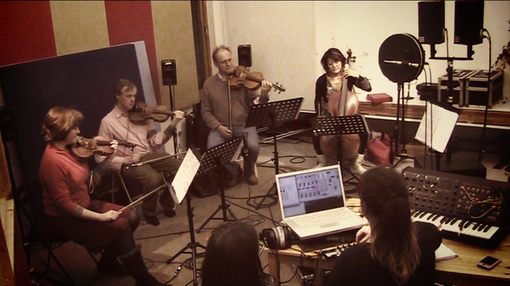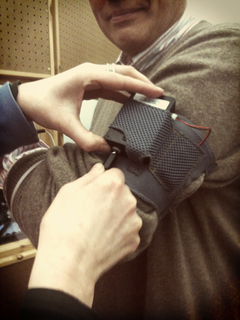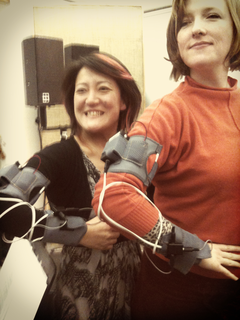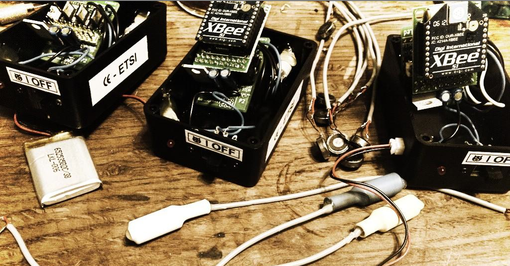Tue 5 Feb 2013
Lauren_Sarah_Hayes.mp3 (MP3 Audio - 23.65Mb)
The McFall’s Electronics project was the perfect opportunity for me to explore many current questions within my own compositional research in a workshop situation, without the added pressure of having to complete the piece of work for immediate performance, which can often detract from the exploratory process. I had three main themes that I wanted to explore: firstly, how an open structure score would translate from conception through to realisation; how plausible it would be to incorporate improvisation (something that is an important part of my own practice) into the piece, and how notation might support/hinder this; and thirdly, I wanted to work with new technology that I have been developing over the last four years as part of my PhD.

The technology consists of small vibrating units, worn on the arms of the performers, which transmit buzzes related to the music. This was first developed for my own performances, to enable me to receive haptic information about the electronic sound that is not felt from electronic or digital equipment in the same way that it is felt through the body of a piano, or indeed a string instrument. I subsequently used the device as a networked improvisation system (NeVIS), which was developed with composer and new media artist, Christos Michalakos. But working with McFall’s Chamber would be the first time that I’d used the technology on a professional ensemble.
In the morning we concentrated on the musical ideas, sans technology, and I processed the ensemble through software in Max/MSP, and performed along with them using the laptop, controllers and my Korg MS20 analogue monosynth. Pippa patiently conducted everyone, standing in for the vibration cues, as I wanted to concentrate on the timbral qualities of the piece first. The piece, entitled subspace, beings with the players moving between notated cells in a star formation, with only a small amount of rules. The music would reflect a state of altered perception, feeling almost trapped, with lots of visible effort yet only the tiniest audible sounds (silent fingering, and mostly ppp). The electronics should be static and contain elements of noise, permeating the space, as if the listener were underwater, on a plane, or in another state.
I had brought the Korg mainly to explore how the natural harmonic series that could be evoked through its filters (especially the low pass) would work with harmonic glissandos of the strings. Of course this was an obvious fit, and sounded almost clichéd at first, but Pippa suggested that more stasis within the movement would help here, which it did, producing broken, yet related harmonic material.


In the afternoon we worked with the vibrotactile devices. These had been developed during a residency at STEIM (Studio for Electro-Instrumental Music) in Amsterdam. There I worked with Marije Baalman using her Sense/Stage project to make the system wireless for performance. We tried the third section of the piece, which was simply a series cued attacks, directed by a strong vibration. Musically, for me this worked very well, and Pippa crucially suggested that we try the section without the vibration, for comparison, and it simply did not have any of the tension/energy that it needed. Similarly, the direction that the vibrations provided for the first section on the whole seemed to work well, and I was happy with the musical realisation and structure.
It was a long day, but extremely fruitful. Despite my worries that my aesthetic and approach would be problematic, I felt that by the end of only a few hours, the piece was sounding as I had hoped. We had many interesting discussions about improvisation, notation and the role of the technology, and Pippa pushed me to explore things further with various suggestions, which really helped to validate my research and suggest that the technology did in fact have an impact on the musical outcomes. In my experience, a composition that involves electronics needs adequate time, and getting to work with the players in this way is crucial to the development of the piece. I will now be able to focus on completing the composition, having spent this valuable time with McFall’s.
I would like to thank Brian, Robert, Rosenna, and Su-a for their openness and enthusiasm… and for being my guinea pigs! Thanks to Ben for great tech, and my gratitude to Pippa for the brilliant mentoring and advice, throughout the day. Thanks also go to Marije Baalman for all her help in getting Sense/Stage working properly, and to Tobias Feltus for designing and assembling the wearable technology for the players that housed the xBees and motors.
http://www.laurensarahhayes.com
